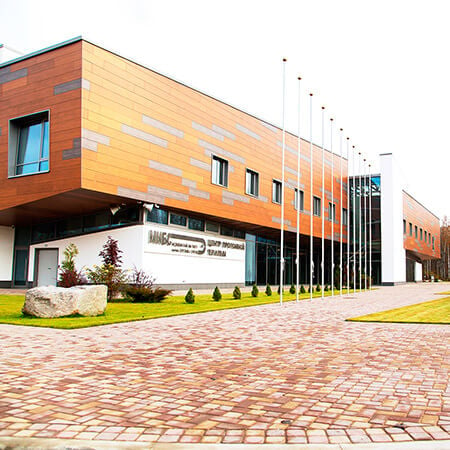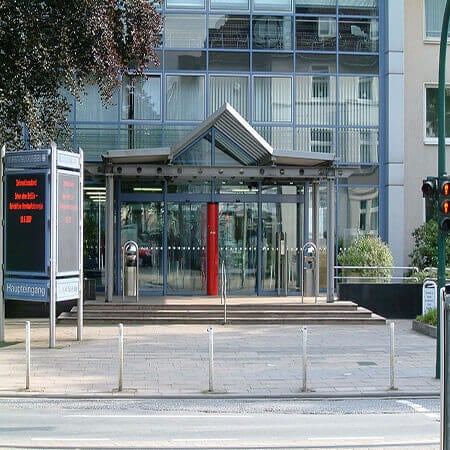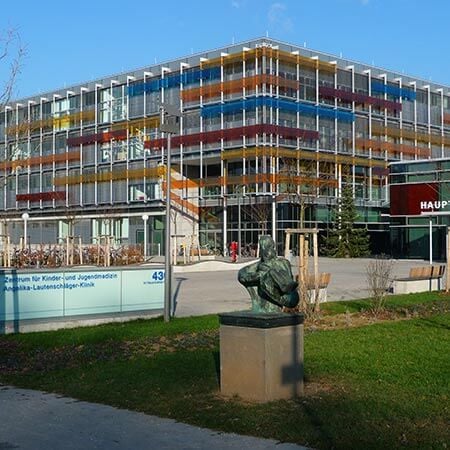Cancer — Proton Therapy: treatment in the Best Hospitals in the World
Treatment prices are regulated by national law of the corresponding countries, but can also include additional hospital coefficients. In order to receive the individual cost calculation, please send us the request and medical records.

Department of Proton Therapy
The Department of Proton Therapy specializes in the treatment of cancer in adults and children using the innovative Varian Probeam system. Proton therapy is the most accurate, safest and most sparing method of radiation therapy for cancer. The technique allows the doctors to effectively destroy malignant cells by increasing the dose of radiation and at the same time has a minimal negative effect on healthy organs and tissues. The department's specialists annually admit more than 800 patients from Russia and other countries of the world, including Australia, Canada, Great Britain, Israel and Kuwait. The department has been operating since 2017, but in such a short time it has managed to gain an excellent reputation in the field of its competence. The treatment success rates are comparable to those of the best clinics in Europe and the USA.


Department of Adult and Pediatric Proton Therapy
The Department of Adult and Pediatric Proton Therapy offers the full range of proton treatment and it is one of the leading and most progressive medical facilities of this kind not only in Germany, but throughout the world. The proton therapy is mostly used for the treatment of tumors of the eye, brain, spine and pelvic organs. Also, the proton therapy is an excellent treatment of tumors in children, since it has a minimal negative effect on the immature, sensitive tissues of the child’s body.







National Center for Tumor Diseases (NCT) Heidelberg
The National Center for Tumor Diseases (NCT) Heidelberg offers the full range of diagnostics and treatment of various oncological diseases. Since its foundation in 2004, the center has gained a reputation of one of the leading in Germany. The center is supported by the German Cancer Research Center (DKFZ) and the German Cancer Aid (Deutschen Krebshilfe). The center treats about 60,000 patients from 45 countries every year. Thanks to the outstanding research activities, the department has the very latest therapeutic opportunities that save lives for thousands of people.

Despite the progress made as a result of the introduction of modern methods of cancer treatment, a cancer diagnosis is one of the biggest problems in modern medicine. In developed countries, about one in three people have cancer and one in five patients dies from it. A cancer diagnosis is becoming a big problem for healthcare systems around the world.
Cancer treatment options
In modern medicine, there is a wide range of treatment options for various oncological diseases, depending on the stages of the malignant process. Since the risk of cancer is quite high, scientists are inventing new ways to treat cancer diagnosis.
Currently, there are three main cancer treatment options: surgery, chemotherapy, and radiation therapy.
- Surgery.
During surgery, a doctor removes not only malignant tumors but also tissues located nearby. Also, the affected lymph nodes are subject to removal. This is done to prevent the recurrence of cancer. This method of treatment depends on the individual peculiarities of the health condition of patients. The accessibility of the tumor indicates whether the surgery will be effective. In many cases, the tumor cannot be removed surgically, or in the presence of metastases the surgery simply won’t be effective.
- Chemotherapy.
Usually, chemotherapy is carried out in combination with surgery and/or radiation therapy. The course of chemotherapy treatment varies from 4 to 6 months in the presence of a small number of cancer cells. It is carried out with short interruptions, during which healthy cells of the body have time to recover.
- Radiation therapy.
As with previous treatment options, radiation therapy is performed either independently or in combination with chemotherapy and/or surgery. The correct calculation plays a significant role in radiation therapy performing, since the correct calculation reduces the risk of subsequent negative effects on the body. The period of treatment with radiotherapy is 6 to 8 weeks. It is carried out for 5-20 minutes about 5 times a week.
The treatment plan is developed during the preliminary consultation by several attending physicians: surgeon, chemotherapist, and radiologist. Usually, all three methods are combined to achieve the best result.
Proton beam therapy
Radiation therapy can be carried out internally and externally. One of the popular methods of internal radiation therapy is brachytherapy. However, its use is limited by the anatomical localization of the tumor and the low accuracy. The list of indications for brachytherapy is also limited in comparison to external radiation therapy.
External radiation therapy implies receiving radiation from a source outside the patient's body. Among the variety of particles, positively charged particles called protons are most often used in clinical practice. Here’s why.
The main advantage of proton beam therapy is the fact that it transmits the absolute majority of its energy in the region of the so-called Bragg peak (directly to the tumor), where the maximum destructive effect is focused. The accelerated proton beam has high energy and is directed precisely. It transfers most of the energy to the tumor tissue, with less damage to healthy tissues near the tumor.
With conventional photon radiation therapy, there is a gradual loss of energy, thus only part of it gets to the tumor. When a tumor is irradiated, healthy tissues are often damaged, especially those that are very sensitive to radiation (the brain and spinal cord, lungs, mucous membranes of the digestive tract, especially tissues of a developing child's body).
The cost of treating a tumor with conventional radiation therapy can be relatively high in terms of both early and late clinical side effects, as healthy tissues are not sufficiently protected from the clinical effects of proton therapy radiation.
As for proton therapy, 70-80% of the energy of the proton beam gets to the center of the tumor. After reaching the tumor, the proton beam energy is reduced to zero. The tissues located near the tumor, in contrast to the conventional radiation therapy, are more protected. Thus, the modern technology of proton beam therapy can treat a wide range of cancer types in patients. For instance, proton therapy for stage 4 esophageal cancer spares lungs and heart, which is impossible with the conventional radiation therapy.
Therefore, it is obvious that the use of proton beam therapy is justified when the conventional radiation therapy does not allow the local clinical control of cancer.
Indications for proton beam therapy
Proton beam therapy is used to treat different types of cancer while being used independently or in combination with other options of treating cancer patients. Besides, proton therapy can be combined with surgery and chemotherapy. Doctors can also recommend proton therapy for stage 4 cancer.
The following clinical conditions can be treated with proton beam therapy:
- Brain cancer.
Proton therapy for cancer of the brain is generally recommended because of the tumor’s proximity to vital brain tissues. Moreover, primary brain tumors that generally start in the brain are eligible for proton beam therapy as well.
Because the procedure is so precise, brain cancer treatment with proton beam therapy allows for highly effective and potentially higher doses of radiation to target the tumor, with less injury to surrounding tissues, lower risk of neurological damage, hormonal deficiencies, or intellectual impairment in patients; maximizing tumor control while minimizing side effects.
- Cancer in young patients.
- Lung cancer.
Proton beam therapy delivers less radiation to the healthy lungs and other nearby organs than X-ray radiation.
- Prostate cancer.
Proton therapy for cancer of the prostate is a treatment option that involves using beams of proton particles to destroy malignant neoplasms. Proton therapy can treat cancer by delivering precise, high doses of radiation to accurately target cancer cells without causing damage to healthy tissue surrounding the prostate.
- Breast cancer.
Patients who have undergone the conventional radiation therapy for left-sided breast cancer are more likely to develop ischemic heart disease, i.e. a severe heart condition caused by narrowed arteries. The higher the radiation dose is, the greater is the risk of side effects and complications. Proton beam therapy helps to avoid this.
Side effects
Proton beam therapy may cause side effects associated with the death of cancer cells or damage to healthy tissues. However, compared to traditional radiation therapy, proton beam therapy has a lower risk of side effects as it is more controllable in terms of the radiation energy emitted. The kind of side effects with proton therapy depends on the area of exposure.
Some of the side effects of proton therapy include:
- Fatigue
- Hair loss on the irradiated part of the body
- Irritation of the skin in the area of radiation
Proton beam therapy is a local treatment method. Due to the ability to accurately focus the proton beam on the tumor, the surrounding healthy tissues and organs are protected maximally. It usually affects only the irradiated area of the body. The phenomena of irritation of the skin or mucous membranes are found in some patients, which most often completely disappear during two to three weeks after the end of the course of treatment.
After proton therapy for cancer of the prostate, there may be a burning sensation when urinating. However, these side effects are easily controlled or go away on their own within several weeks.
Most often, patients may experience fatigue, mood changes or appetite loss, or other side effects. This is due to the body's efforts to recover from radiation. In general, side effects that proton beam therapy may cause are individual and depend on the site of irradiation, the dose of radiation, and the number of irradiation sessions. Besides, patients have different sensitivity to radiation.
During the first consultation, specialists discuss with each patient the possible side effects. Patients are constantly monitored during treatment. If any side effects occur, patients should contact a doctor who will take the necessary measures.
Benefits of proton beam therapy
The information from clinical tria;s show that during the traditional photon radiation X-rays damage inevitably the healthy tissue. In the alternative treatment by the method of proton beam therapy, the beam "hits the target" more accurately, focusing on the tumor most of the radiation energy with almost no residual radiation.
Again, due to the greater precision of the beam, the destruction of the tumor can be carried out in fewer sessions.
Proton beam therapy is a highly effective method of radiation therapy, primarily due to the physical properties of protons and the specifics of distribution of radiation doses. With this method, it is possible to achieve high local control of the tumor, less damage to healthy tissues, a low risk of complications, and a chance for faster recovery.
Advantages of proton therapy compared to the conventional radiotherapy include:
- Minimal damage to healthy tissues and the resulting possibility of treating tumors located near important organs and systems, which is a clear advantage in treatment of tumors in pediatric patients
- Low risk of side effects during and after radiation therapy with faster recovery of patients after the end of treatment
- Accurate focusing irradiation on the tumor and the maximum sparing ratio for healthy tissues during irradiation can significantly reduce the risk of secondary malignant tumors development
- High probability of destruction of tumor cells and the better long-term survival of patients
- Ultimately, saving financial resources of patients that are associated with follow-up medical care for an untreated patient or a patient with severe side effects after the treatment
Thus, proton beam therapy reduces the risk of side effects that are severe enough to lead to unplanned hospitalizations for cancer patients. The information from the clinical trials indicates that the proton beam therapy is a safer form of radiation therapy to treat cancer.
Where can I undergo proton beam therapy?
Health tourism is becoming more and more popular these days, as treatment abroad ensures a much better quality of overall cancer care and proton beam therapy specifically.
The best success rates in proton beam therapy show:
- Proton Therapy Center of Dr. Berezin Medical Institute (MIBS) Saint Petersburg, Russia
- University Hospital Essen, Germany
- University Hospital Heidelberg, Germany
- Proton Therapy Center Prague, the Czech Republic
You can check out the full list of hospitals on the Booking Health website.
The cost for proton therapy treatment
The prices in hospitals listed on the Booking Health website are relatively low. With Booking Health, you can undergo cancer treatment with proton therapy in the best hospitals in the world at an affordable price.
The cost of treatment varies, as the prices depend on hospitals, the features of the disease, and the complexity of its treatment.
The cost of treatment with proton therapy in different German hospitals ranges from 84,000 EUR to 87,000 EUR.
You might want to take into account the cost of the possible additional treatment and follow-up care. Therefore, the ultimate cost for proton therapy treatment may differ from the initial price.
To receive the information on the cost of treatment, contact us by leaving the request on Booking Health website.
How can I undergo treatment with proton therapy?
It is not easy to self-organize any treatment abroad. It requires certain knowledge and expertise. Thus, it is safer, easier, and less stressful to shift some responsibility onto a medical tourism agency.
As the largest and most transparent medical tourism agency, Booking Health has up-to-date information on proton beam therapy in the best hospitals in the world. With accurate information on the success rates of different hospitals in proton beam therapy, Booking Health will help you select a medical facility for proton therapy, taking into account your wishes for treatment.
We want to help you during this difficult time and take on all the troubles. You can be free of unnecessary stress, while Booking Health takes care of all organizational issues. Our goal is to find the best medical facility for you, where you can undergo proton beam therapy safely.
Medical tourism can be easy! All you need to do is to leave a request on the Booking Health website, and our manager will contact you shortly.

